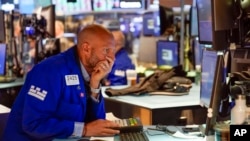U.S. stock indexes edged slightly lower Tuesday at the opening of trading after sliding steeply into a bear market on Monday, down nearly 22% from their peak in early January.
The benchmark Dow Jones Industrial Average of 30 blue chip stocks, the broader S&P 500 index and the technology-heavy Nasdaq index all were down marginally.
European indexes were mixed in afternoon trading. In Asia, Shanghai advanced, while Hong Kong ended flat, and Tokyo declined.
U.S. investors were awaiting news from policymakers at the country’s central bank, the Federal Reserve, as they opened a two-day meeting in Washington to consider another increase in the benchmark interest rate, which could be as much as three-quarters of a percentage point when the announcement is made on Wednesday.
The Fed’s rate heavily influences borrowing costs for businesses to buy supplies and raw materials and for consumers to buy homes, cars and retail products. The Fed’s assumption is that higher interest rates will deter spending and pare the inflation rate over time to its desired annual rate of 2%.
Currently, however, U.S. consumers are facing the biggest annual surge in U.S. prices in four decades, registered at 8.6% in May, according to the government. Housing costs, the price of groceries and gasoline have all advanced sharply, squeezing the household budgets of many American families.
Analysts point to several culprits for the inflation surge. U.S. consumers are spending again despite higher prices after staying home during the worst of the coronavirus pandemic; supply chain issues have cut the number of products reaching store shelves; and international turmoil brought on by Russia’s invasion of Ukraine has roiled global oil markets.
The S&P 500 lost 3.9% on Monday, dropping it 21.8% below its January 3 peak and into a bear market — the first since a brief, sharp decline two years ago when the pandemic first hit the U.S.







